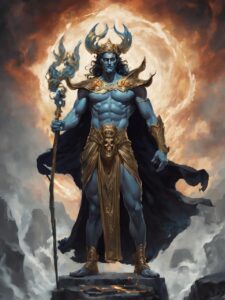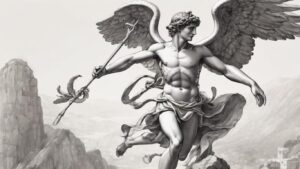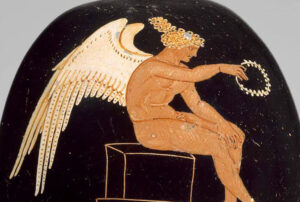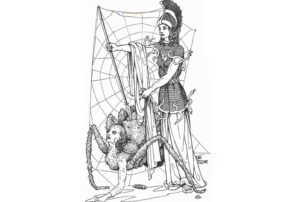Table of Contents
Greek mythology, a captivating tapestry of gods and heroes, shapes the foundation of ancient storytelling. Among the Olympian deities, Hades, the enigmatic god of the underworld, commands attention.
Transitioning into the rich narratives, Hades stands as one of the triumvirate siblings, alongside Zeus and Poseidon. This divine trio governs the realms of the sky, sea, and the shadows below. Hades, often overshadowed by his more extroverted counterparts, holds a unique role.
Amidst the vibrant tales of gods and mortals, Hades’ dominion over the afterlife adds depth to the Greek mythos. His realm, shrouded in mystery and darkness, becomes the final destination for departed souls. Here, Hades wields power over life beyond the mortal coil.
In the pantheon, each deity plays a distinct role, contributing to the cosmic balance. Hades’ responsibilities involve overseeing the spirits of the deceased, ensuring a just and orderly transition to the afterlife. Amidst the splendor of Olympus, his role is crucial yet often overlooked.
Transitioning from the celestial heights to the underworld’s depths, Hades’ realm becomes a focal point. It’s a realm not only of shadows and spirits but also a testament to the intricate weaving of life and death in the ancient Greek worldview.
In this exploration of Greek mythology, Hades emerges as a figure both mysterious and integral. The tales surrounding him unveil a deity with a nuanced role, contributing to the broader narrative of divine dynamics and human existence.
The God of the Underworld
Hades, a pivotal figure in Greek mythology, is intrinsically linked to Zeus and Poseidon as their sibling. Born from Cronus and Rhea, the three siblings govern distinct realms—Zeus reigning over the sky, Poseidon over the sea, and Hades over the underworld.
Transitioning to Hades’ unique attributes, he possesses a crown forged from adamant, rendering him invisible. This mystical accessory grants him the ability to move unseen among both gods and mortals. Such invisibility symbolizes the subtle but pervasive influence of the underworld in the mortal realm.
In his dominion beneath the earth, Hades holds sway over the afterlife. Departed souls find themselves under his jurisdiction, subject to the god’s judgment. This rule extends beyond mere governance; it represents a profound connection to the cyclical nature of life, death, and rebirth.
Despite being a deity of the underworld, Hades is not a malevolent force. His role is more than that of a stern judge; he ensures the souls entrusted to him find their rightful place. This balance reflects the intricate dynamics of the Greek pantheon, where each god plays a crucial part in the cosmic order.
Transitioning from the celestial heights of Olympus to the depths of the underworld, Hades emerges as a deity both feared and respected. The crown of invisibility and his rule over the afterlife illustrate not only his unique powers but also the essential role he plays in the broader mythological narrative.
Mysterious and Enigmatic
In the rich tapestry of Greek myths, Hades rarely steps into the limelight, preferring the shadows. His appearances, though infrequent, hold profound significance. Transitioning to his demeanor, Hades maintains a stoic and reserved presence, distinct from the more flamboyant gods.
Even amidst the vibrant tales of Olympus, Hades remains enigmatic. His choices reflect a deliberate avoidance of the attention sought by his fellow deities. Transitioning from the extroverted Zeus and Poseidon, Hades embodies a more introverted essence, finding solace in the solitude of his subterranean realm.
In the narratives, when Hades does emerge, his actions are measured and purposeful. His enigmatic nature serves as a reminder of the quiet strength inherent in the unseen forces of the underworld. Transitioning from the boisterous narratives of the Olympians, Hades becomes a symbol of the subtle but powerful influence that shapes the mortal and divine realms.
While Zeus commands thunderbolts and Poseidon rules the tempestuous seas, Hades governs the silent realm beneath the earth. His infrequent appearances and reserved demeanor contribute to the mysterious allure surrounding the god of the underworld. In the intricate pantheon, Hades stands as a testament to the diversity of personalities, showcasing that even in the realm of gods, strength isn’t always loud, and power isn’t always ostentatious.
Balanced Deity
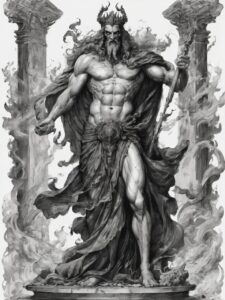
Hades, a deity often misunderstood, plays a pivotal role in the cosmic balance between life and death. Transitioning to his responsibilities, he ensures departed souls find their rightful place in the underworld.
In the grand tapestry of Greek mythology, Hades governs with impartiality. His role extends beyond judgment; it encompasses guiding souls to their destined afterlife. Transitioning from the vibrant world of the living to the shadowy realm below, Hades orchestrates a seamless transition for departed souls.
Despite his association with the afterlife, Hades is not a malevolent force. Instead, he embodies the necessary and natural order of existence. His actions maintain equilibrium in the intricate dance between mortality and the divine. Transitioning from the lively narratives of other gods, Hades becomes a guardian of cosmic balance, ensuring that life and death remain intertwined yet harmonious.
The underworld, under Hades’ rule, isn’t a realm of eternal punishment but a destination dictated by one’s deeds in life. Transitioning from the misconceptions, Hades emerges as a just and vital figure, contributing to the cyclical nature of existence. His balanced approach to the afterlife reflects the broader Greek worldview that embraces the dualities inherent in the human experience.
In essence, Hades is not a deity solely associated with death; he is a custodian of the cosmic order. His role in guiding souls mirrors the delicate balance required for the continuation of life’s eternal cycle. Transitioning from the misconceptions surrounding Hades, one can appreciate his nuanced role in preserving the equilibrium between life and death.
Worship and Ceremonies
In ancient Greece, ceremonies honoring Hades were integral to seeking favor and protection for departed loved ones. Engaging in sacred rituals, families invoked Hades’ benevolence.
These ceremonies occurred in sanctuaries dedicated to the god of the underworld. Families gathered, offering prayers and sacrifices to ensure a smooth journey for departed souls. Transitioning from bustling life to solemn ceremonies, Greeks believed in their actions’ significance.
Worshippers aimed to secure a peaceful afterlife for loved ones by appeasing Hades. Moving from mortal uncertainties, ceremonies provided a connection with the divine, assuring departed souls’ solace.
These rituals weren’t acts of fear but expressions of respect for the natural order. Transitioning from vibrant life to contemplative rituals, Greeks recognized Hades’ role in the cycle of life and death.
Ancient practices reflected communal efforts to navigate the mysteries of the afterlife. Transitioning from mortal uncertainties to the divine realm, worship of Hades highlighted interconnectedness between the living and the dead. In these ceremonies, Greeks honored the god and sought solace, believing departed loved ones were under his watchful eye.
Just and Reluctant
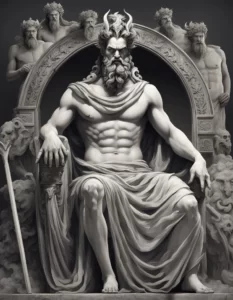
Hades emerges in Greek myths as a deity both just and impartial in his judgments. Transitioning to these instances, his portrayal contrasts with the common perception of a stern judge. Despite his role in the afterlife, Hades reveals a softer side in the myth of Orpheus and Eurydice.
In the myth, Orpheus, a gifted musician, descends to the underworld to retrieve his beloved Eurydice. Hades, moved by Orpheus’s heartfelt music, reluctantly agrees to release her. Transitioning from the typical narratives of unyielding deities, this moment displays Hades’ capacity for compassion.
However, there’s a condition: Orpheus must lead Eurydice out of the underworld without looking back. Tragically, he fails, losing her forever. Transitioning from a potential happy resolution to a heartbreaking outcome, this showcases the complexity of Hades’ character.
The myth challenges the conventional perception of Hades as an implacable ruler. Transitioning from the stoic demeanor associated with the god of the underworld, this episode highlights a nuanced understanding of his character. Hades, in this instance, becomes a figure not solely defined by severity but one capable of empathy.
This portrayal adds depth to Hades’ character, revealing layers beyond the god of death. Transitioning from the realm of rigid judgments to a moment of reluctant concession, Hades becomes a deity entwined with the intricate emotions and stories that shape Greek mythology. In the myth of Orpheus and Eurydice, Hades’ just and reluctant nature blurs the lines between the divine and the human, emphasizing the multifaceted aspects of his character.
Symbols
In artistic representations, Hades is often depicted alongside Cerberus, a three-headed dog guarding the underworld’s entrance. Shifting to these depictions, Cerberus symbolizes Hades’ formidable dominion over the dead.
Cerberus, with its three heads and serpent-like tails, is a menacing guardian. Moving from the calm demeanor often associated with Hades, Cerberus represents the ferocity inherent in the god’s realm.
The three heads of Cerberus are said to symbolize the past, present, and future. Progressing from the straightforward imagery of a guard dog, this symbolism suggests Hades’ awareness and control over the entirety of existence.
Hades, in some myths, uses Cerberus to maintain order and prevent souls from escaping. Shifting from the passive image of a pet to an active enforcer, Cerberus becomes a symbol of the god’s vigilance and authority.
The depiction of Hades with Cerberus underscores the god’s role as a guardian and ruler. Moving from the serene images of other gods, this portrayal emphasizes the strength and assertiveness needed to oversee the afterlife.
In conclusion, Cerberus serves as an iconic symbol, representing Hades’ guardianship and dominion over the realm of the dead. Progressing from mere imagery to symbolic significance, the three-headed dog becomes a powerful emblem encapsulating the essence of the god of the underworld.
Role in Greek mythology
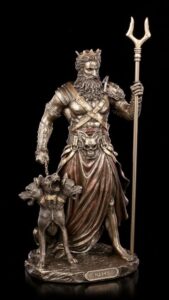
In conclusion, Hades, the god of the underworld, plays a multifaceted role in Greek mythology. Shifting to this recap, his significance lies within the intricate balance of the Greek pantheon.
Hades, often overshadowed, is an integral part of the Olympian triad, alongside Zeus and Poseidon. Moving from the more prominent roles of his siblings, Hades governs the underworld with a quiet strength.
While Zeus commands the skies and Poseidon the seas, Hades oversees the realm of the dead. Progressing from the vastness of the cosmos to the depths of the underworld, Hades’ dominion represents the cyclical nature of life and death.
His role in maintaining balance extends beyond judgment to the guidance of departed souls. Moving from a mere judge to a compassionate guide, Hades embodies the nuanced approach required in the cosmic order.
Despite misconceptions, Hades is not a malevolent force but a custodian of the afterlife’s equilibrium. Advancing from the shadows to the forefront, Hades’ multifaceted nature challenges preconceptions, offering a deeper understanding of his crucial role in Greek mythology.
In the intricate dance of gods and mortals, Hades is a symbol of the unseen forces shaping existence. Progressing from the chaos of myths to the cosmic order, Hades remains a figure of quiet authority, contributing to the timeless balance of the Greek pantheon.
In Modern Culture
Hades, the god of the underworld, has found resonance in modern culture through various mediums. Transitioning to movies, Disney’s “Hercules” portrays Hades as a charismatic and witty antagonist, giving the ancient deity a contemporary twist. Moving from animation to live-action, “Clash of the Titans” presents Hades as a formidable and conflicted character, adding depth to the god’s portrayal.
In literature, contemporary authors explore Hades’ character in novels like “The Song of Achilles” by Madeline Miller, offering a fresh perspective on the god’s relationships and motivations. Transitioning from traditional myths to inventive retellings, these books reimagine Hades for a modern audience.
Video games have embraced Hades as a central figure, notably in the game titled “Hades” by Supergiant Games. Transitioning from static narratives to interactive storytelling, players navigate the god’s realm, exploring his complexities and interactions with other gods.
Beyond fictional works, Hades influences language and pop culture. Transitioning to idioms, phrases like “a trip to Hades” find their way into everyday speech, illustrating the enduring impact of ancient mythology on language.
In fashion and art, Hades serves as a muse, inspiring creative expressions that blend ancient aesthetics with contemporary styles. Transitioning from classical depictions to modern interpretations, artists infuse Hades’ symbolism into diverse forms of visual expression.
Music, too, draws inspiration from Hades’ themes. Transitioning from ancient hymns to contemporary compositions, musicians explore the god’s realm to convey existential questions and emotional nuances.
In conclusion, Hades continues to thrive in modern culture, shaping and adapting to the evolving tastes and creative expressions of today’s society. Transitioning from ancient myths to multifaceted portrayals, Hades remains a captivating and influential figure in the cultural landscape.
FAQ
What is Hades the god of?
Hades is the god of the underworld in Greek mythology, ruling over the realm of the dead.
Who is Hades' wife?
Hades is married to Persephone, the daughter of Demeter, in Greek mythology.
What is Hades' symbol?
Hades is often associated with symbols like the Helm of Darkness (invisibility helmet) and the bident (a two-pronged spear).
What are Hades' powers?
Hades has powers related to the underworld, including control over the dead, the ability to become invisible, and influence over the earth's riches.
What is Hades' Roman name?
In Roman mythology, Hades is equivalent to Pluto, the god of the underworld.
Where does Hades live?
Hades resides in the underworld, a realm beneath the earth where the souls of the deceased go after death.
What does Hades look like?
Hades is often depicted as a mature and bearded god in Greek art. His appearance varies but is generally serious and regal.
What is Hades in the Bible?
Hades in the Bible is a term used in the New Testament, often translated from the Greek word "Hades," referring to the realm of the dead or the grave. The figure of Hades in Greek mythology is distinct from biblical usage.
Why does Odysseus go to Hades, the land of the dead?
In Homer's epic poem "The Odyssey," Odysseus visits Hades to seek guidance from the spirit of the blind prophet Tiresias. He wants to learn how to return home to Ithaca.
What does Hades mean?
"Hades" has multiple meanings. It refers to the god of the underworld in Greek mythology, the underworld itself, and the term is also used in the New Testament of the Bible to signify the realm of the dead or the grave.
Who are Hades' children?
In Greek mythology, Hades is usually considered childless. However, some accounts mention Macaria, Melinoe, and Zagreus as potential offspring, with variations depending on the source.
How to pronounce Hades?
Hades is pronounced as "HAY-deez" in English, with the emphasis on the first syllable.
Is Hades older than Zeus?
Hades and Zeus are siblings, born to the Titans Cronus and Rhea. They are of the same generation.

